CHEVROLET MONTE CARLO 1996 5.G Owners Manual
Manufacturer: CHEVROLET, Model Year: 1996, Model line: MONTE CARLO, Model: CHEVROLET MONTE CARLO 1996 5.GPages: 340, PDF Size: 17.79 MB
Page 201 of 340
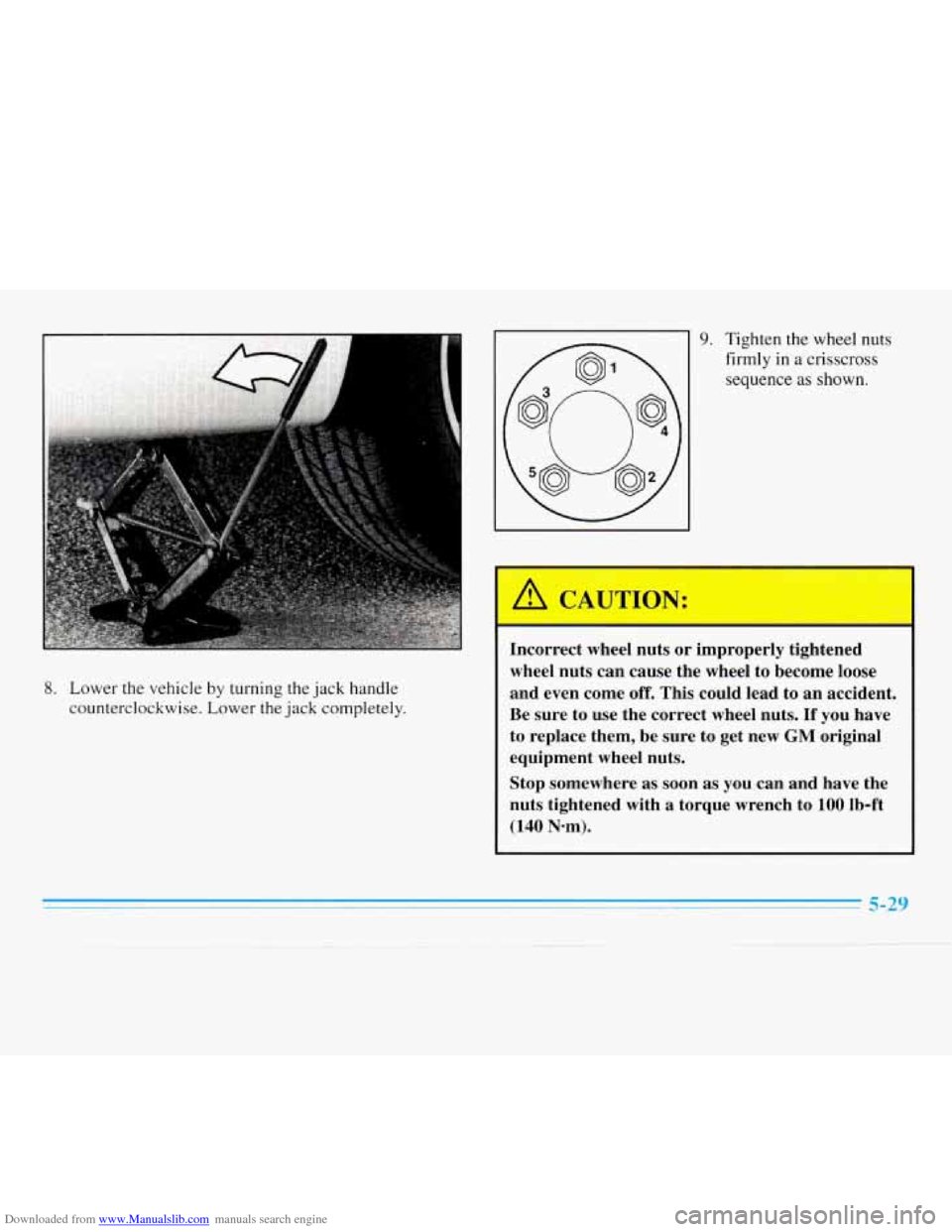
Downloaded from www.Manualslib.com manuals search engine 8. Lower the vehicle by turning the jack handle
counterclockwise. Lower the jack completely.
9. Tighten the wheel nuts
firmly
in a crisscross
sequence as shown.
Incorrect wheel nuts or improperly tightened
wheel nuts can cause the wheel to become loose
and even come off. This could lead to an accident.
Be sure to use the correct wheel nuts.
If you have
to replace them, be sure to get new
GM original
equipment wheel nuts.
Stop somewhere as soon as you can and have the
nuts tightened with a torque wrench to
100 lb-ft
(140 Nom).
Page 202 of 340
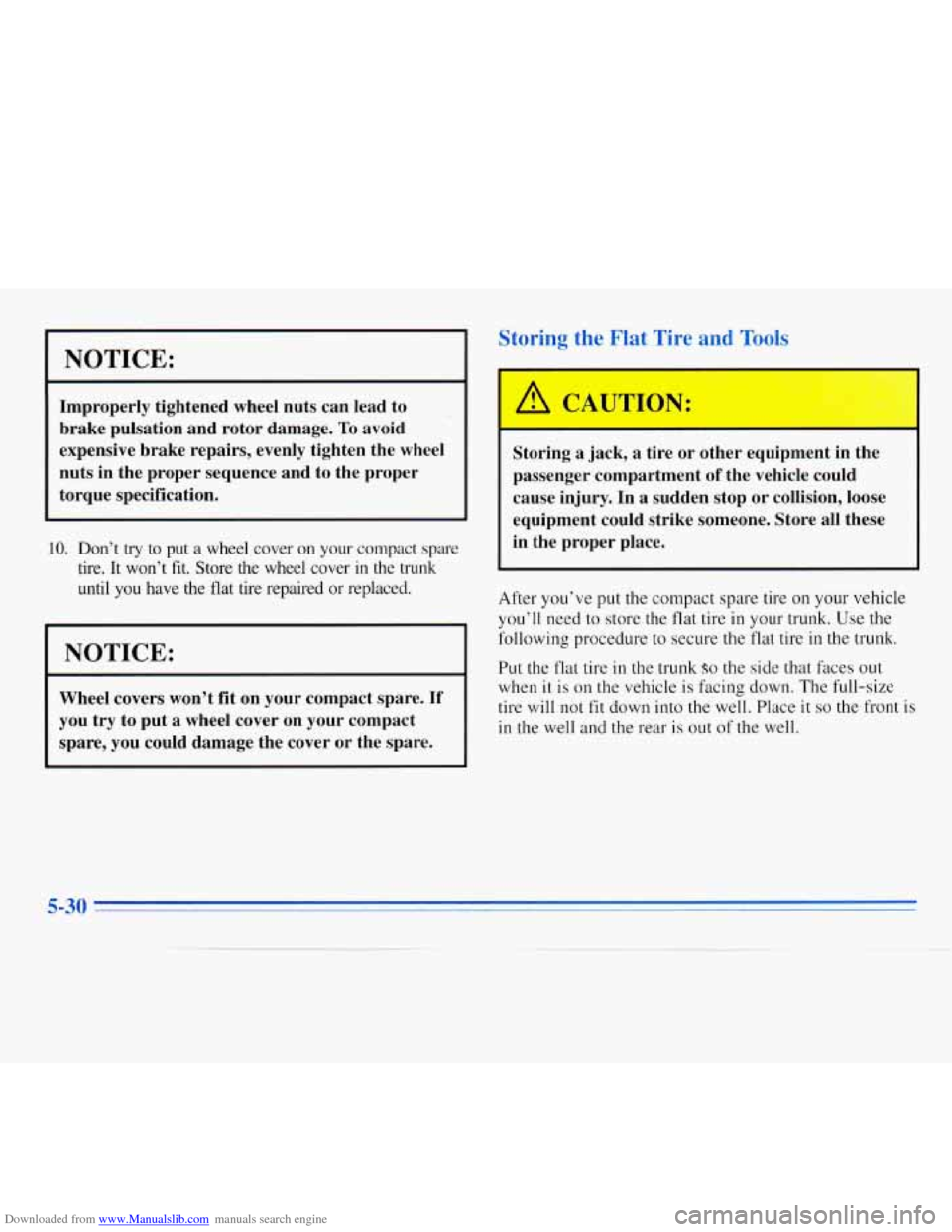
Downloaded from www.Manualslib.com manuals search engine Storing the Flat Tire and Tools
NOTICE:
Improperly tightened wheel nuts can lead to
brake pulsation and rotor damage.
To avoid
expensive brake repairs, evenly tighten the wheel
nuts in the proper sequence and to the proper
torque specification.
10. Don't try to put a wheel cover on your compact spare
tire, It won't
fit. Store the wheel cover in the trunk
until you have the flat tire repaired or replaced.
I NOTICE:
Wheel covers won't fit on your compact spare. If
you try to put a wheel cover on your compact
spare, you could damage the cover or the spare.
I
' A CAUTI(
I
Storing a jack, a tire or other equipment in the
passenger compartment
of the vehicle could
cause injury. In
a sudden stop or collision, loose
equipment could strike someone. Store all these
in the proper place.
After you've put the compact spare tire on your vehicle
you'll need to store the flat tire in your trunk. Use the
following procedure to secure the flat tire in the trunk.
Put the flat tire in the trunk
so the side that faces out
when it is on the vehicle is facing down. The full-size
tire will not fit down into the well. Place
it so the front is
in the well and the rear is out of the well.
5-30
Page 203 of 340
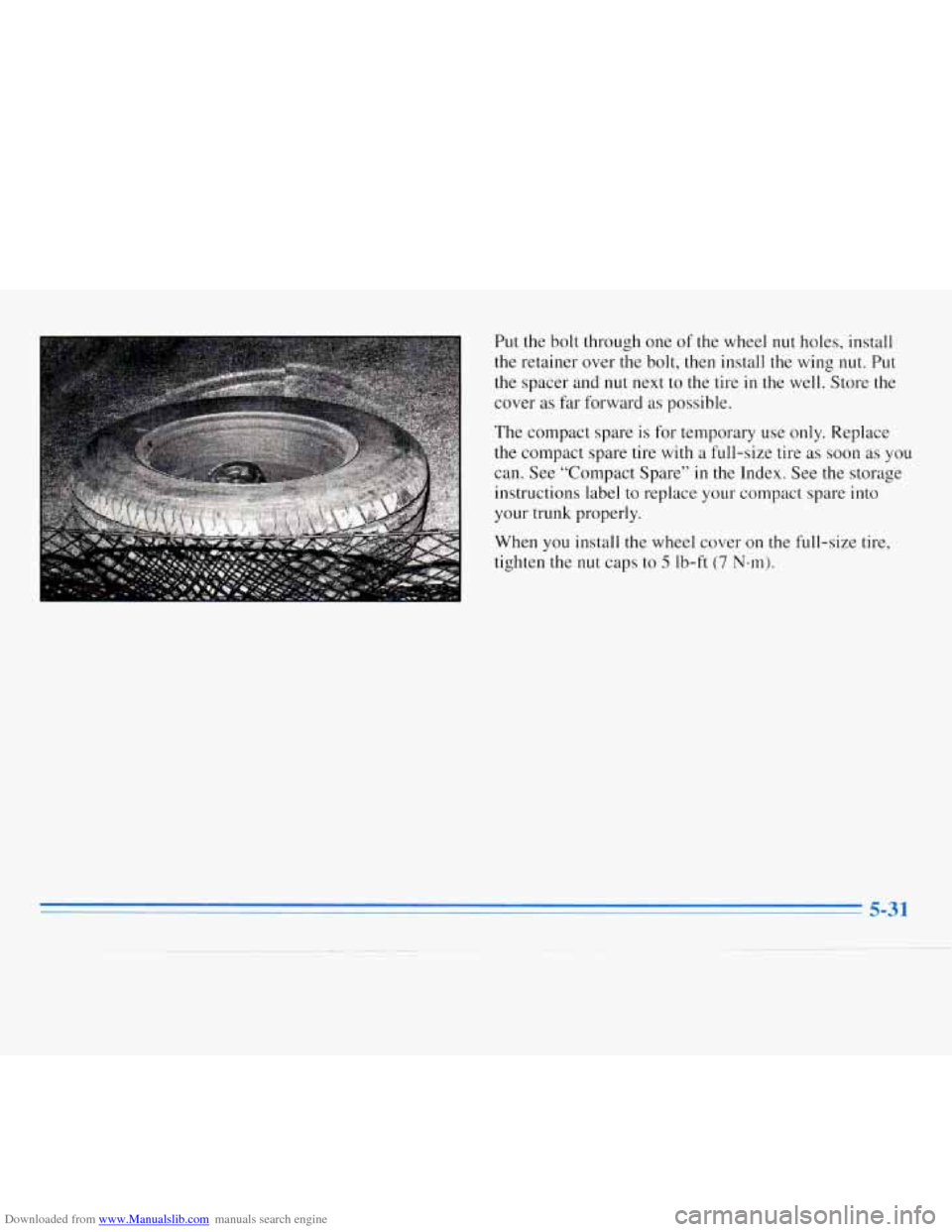
Downloaded from www.Manualslib.com manuals search engine Put the bolt through one of the wheel nut holes, install
the retainer over the bolt, then install
the wing nut. Put
the spacer and
nut next to the tire in the well. Store the
cover
as far forward as possible.
The compact spare
is for temporary use only. Replace
the compact spare tire with a full-size tire as soon as you
can. See “Compact Spare”
in the Index. See the storage
instructions label to replace your compact spare into
your trunk properly.
When you install
the wheel cover on the full-size tire,
tighten the
nut caps to 5 Ib-ft (7 Nsm).
Page 204 of 340
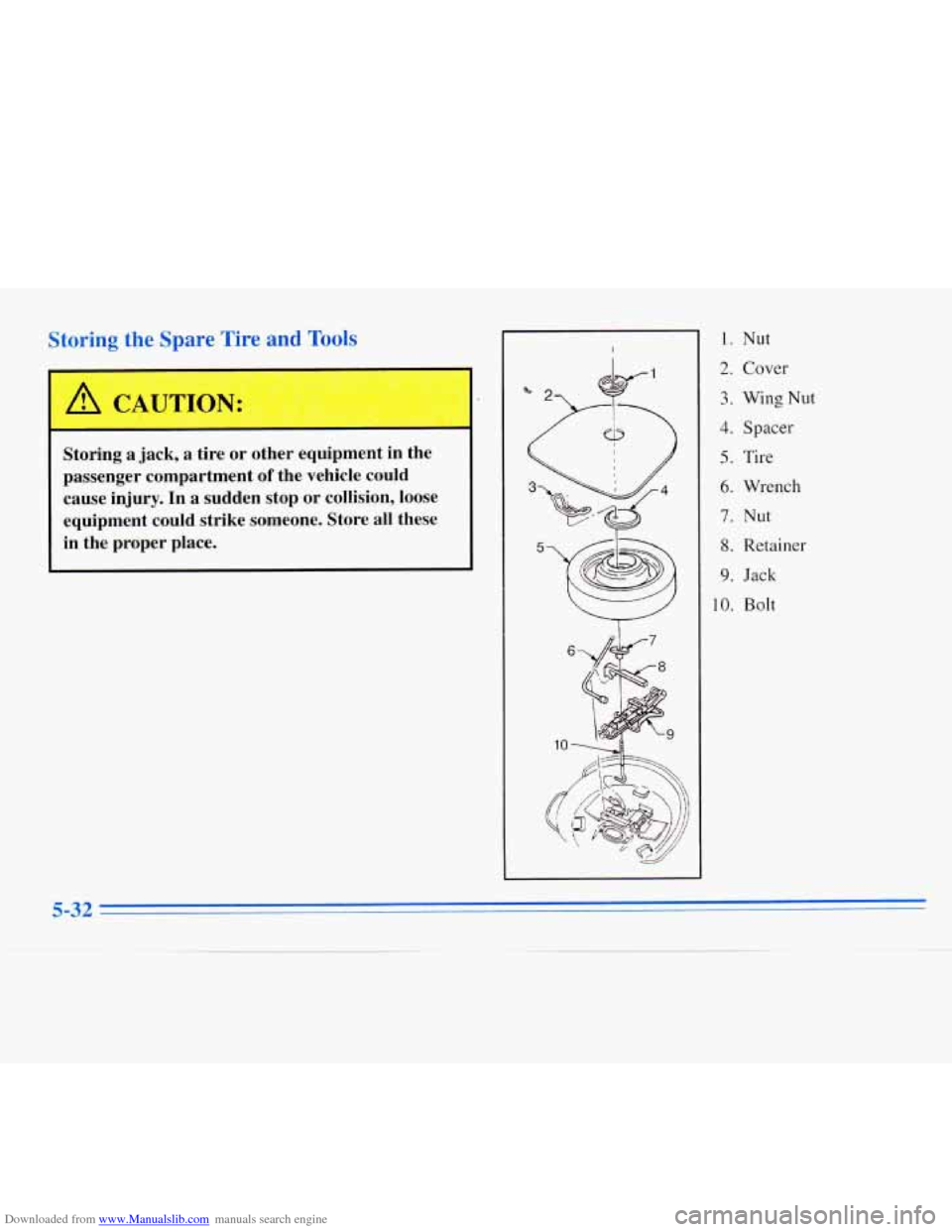
Downloaded from www.Manualslib.com manuals search engine Storin ~ thc $pare Tire and Tools
~A CAUTION:
Storing a jack, a tire or other equipment in the
passenger compartment
of the vehicle could
cause injury. In
a sudden stop or collision, loose
equipment could strike someone. Store all these
in the proper place.
I 1.
2.
3.
4.
5.
6.
7.
8.
9.
10.
Nut
Cover
Wing
Nut
Spacer
Tire
Wrench
Nut
Retainer
Jack
Bolt
5-32
Page 205 of 340
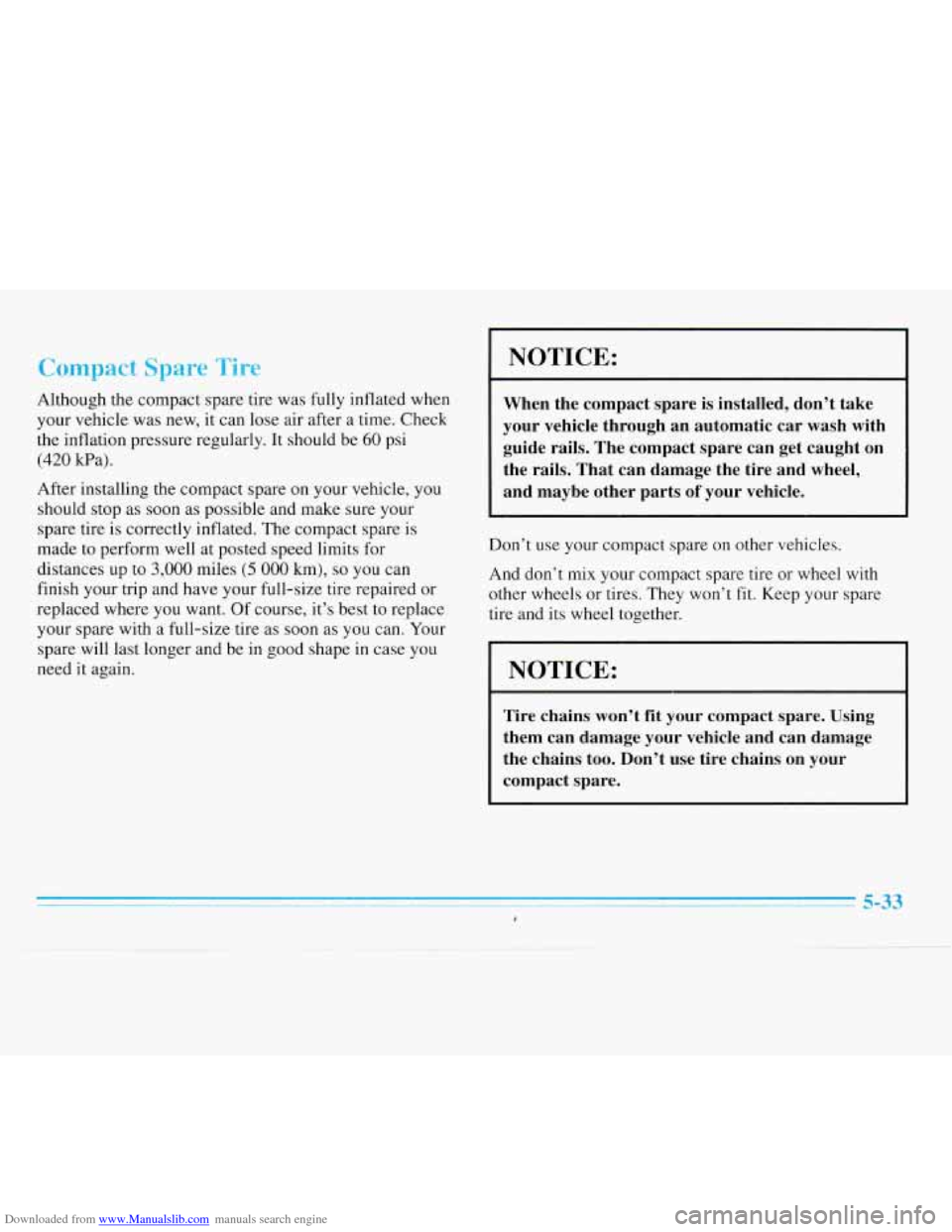
Downloaded from www.Manualslib.com manuals search engine qare
Although the compact spare tire was fully inflated when
your vehicle was new, it can lose air after a time. Check
the inflation pressure regularly. It should be
60 psi
(420 kPa).
After installing the compact spare on your vehicle, you
should stop as soon as possible and make sure your
spare tire is correctly inflated. The compact spare is
made to perform well at posted speed limits for
distances up to
3,000 miles (5 000 km), so you can
finish your trip and have your full-size tire repaired or
replaced where you want. Of course, it’s best to replace
your spare with a full-size tire as soon as you can. Your
spare will last longer and be in good shape in case you
need it again.
NOTICE:
When the compact spare is installed, don’t take
your vehicle through an automatic car wash with
guide rails. The compact spare can get caught on
the rails. That can damage the tire and wheel,
and maybe other parts
of your vehicle.
Don’t use your compact spare on other vehicles.
And don’t mix your compact spare tire or wheel with
other wheels or tires’. They won’t fit. Keep your spare
tire and its wheel together.
NOTICE:
Tire chains won’t fit your compact spare. Using
them can damage your vehicle and can damage
the chains too. Don’t use tire chains on your
compact spare.
Page 206 of 340
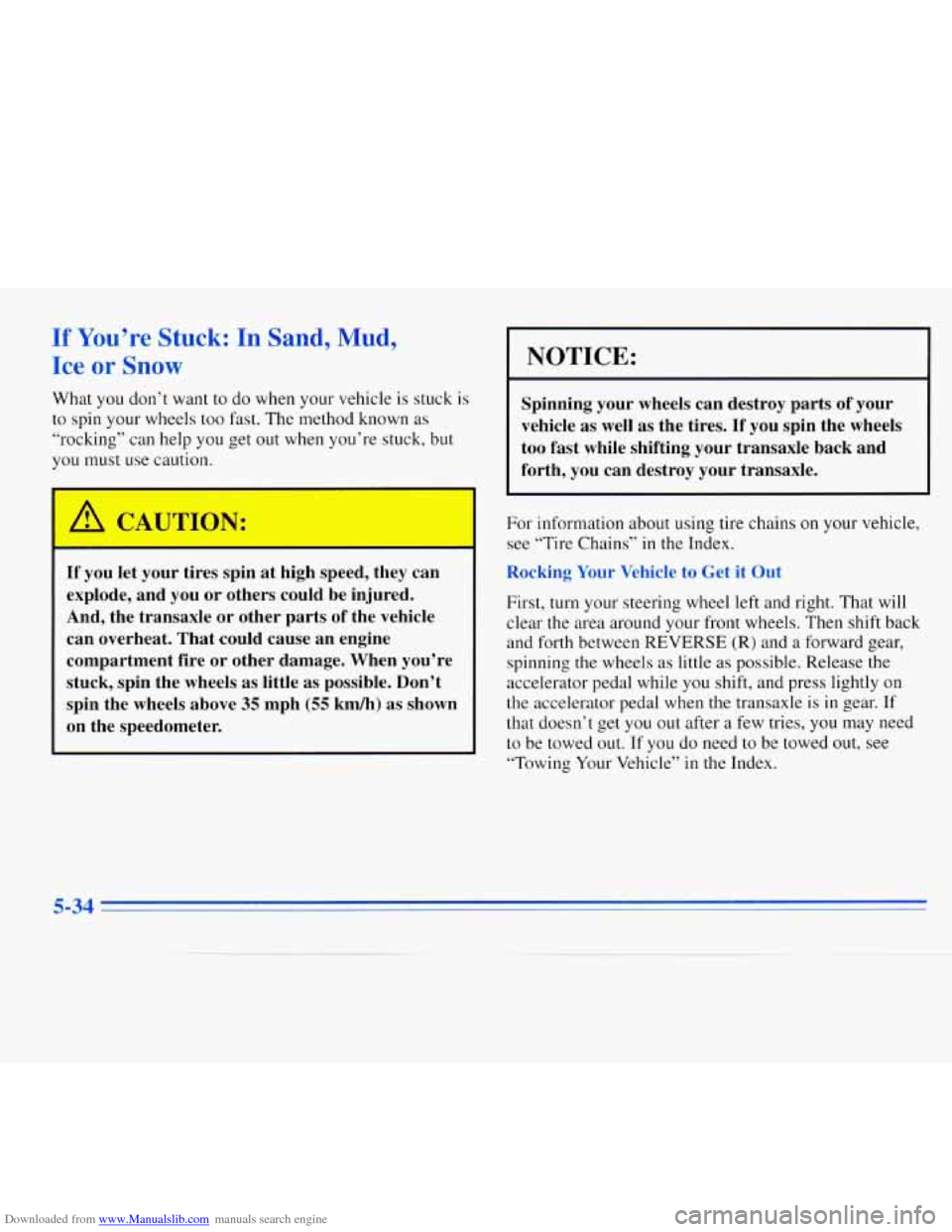
Downloaded from www.Manualslib.com manuals search engine If You’re Stuck: In Sand, Mud,
Ice or Snow I NOTICE:
What you don’t want to do when your vehicle is stuck is
to spin your wheels too fast. The method known
as
“rocking” can help you get out when you’re stuck, but
you must use caution.
Spinning your wheels can destroy parts of your
vehicle as well as the tires.
If you spin the wheels
too fast while shifting your transaxle back and
forth, you can destroy your transaxle.
If you let your tires spin at high speed, they can
explode, and you or others could be injured.
And, the transaxle
or other parts of the vehicle
can overheat. That could cause an engine
compartment fire
or other damage. When you’re
stuck, spin the wheels as little
as possible. Don’t
spin the wheels above
35 mph (55 km/h) as shown
on the speedometer.
For information about using tire chains on your vehicle,
see “Tire Chains”
in the Index.
Rocking Your Vehicle to Get it Out
First, turn your steering wheel left and right. That will
clear the area around your front wheels. Then shift back
and forth between REVERSE
(R) and a forward gear,
spinning
the wheels as little as possible. Release the
accelerator pedal while you shift, and press lightly on
the accelerator pedal when the transaxle is
in gear. If
that doesn’t get you out after
a few tries, you may need
to be towed out.
If you do need to be towed out, see
“Towing Your Vehicle”
in the Index.
5-34
Page 207 of 340
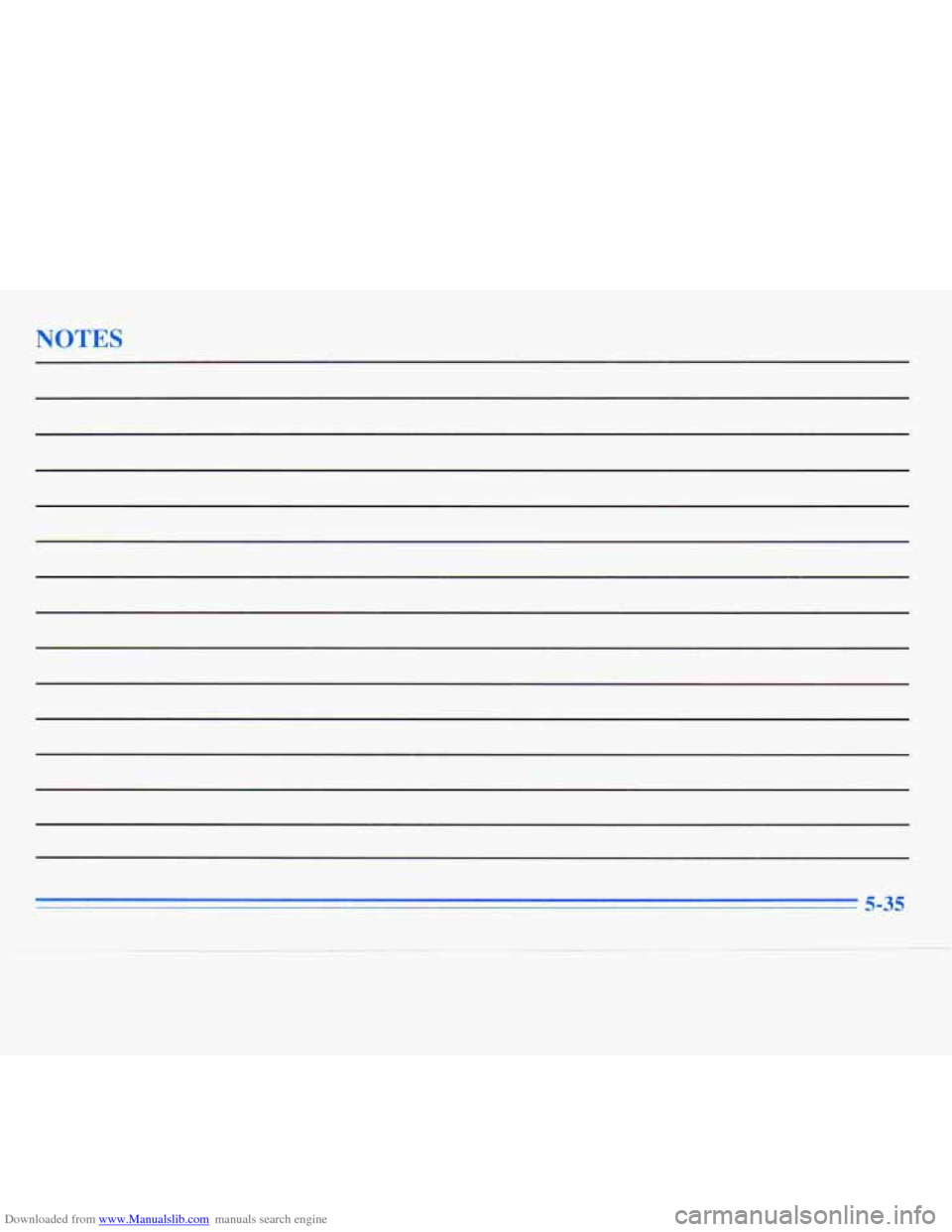
Downloaded from www.Manualslib.com manuals search engine NOTES
5-35
Page 208 of 340
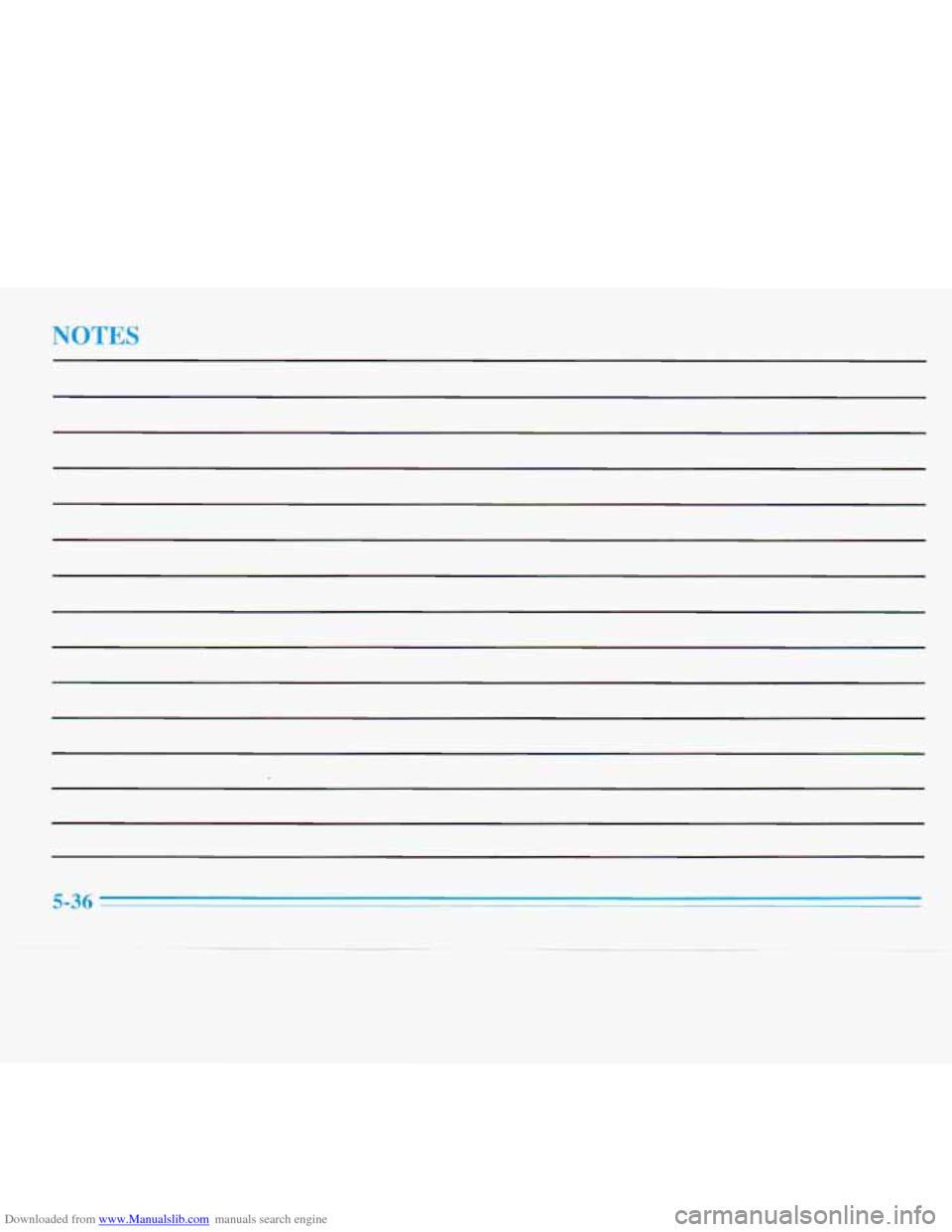
Downloaded from www.Manualslib.com manuals search engine NOTES
5-36
Page 209 of 340
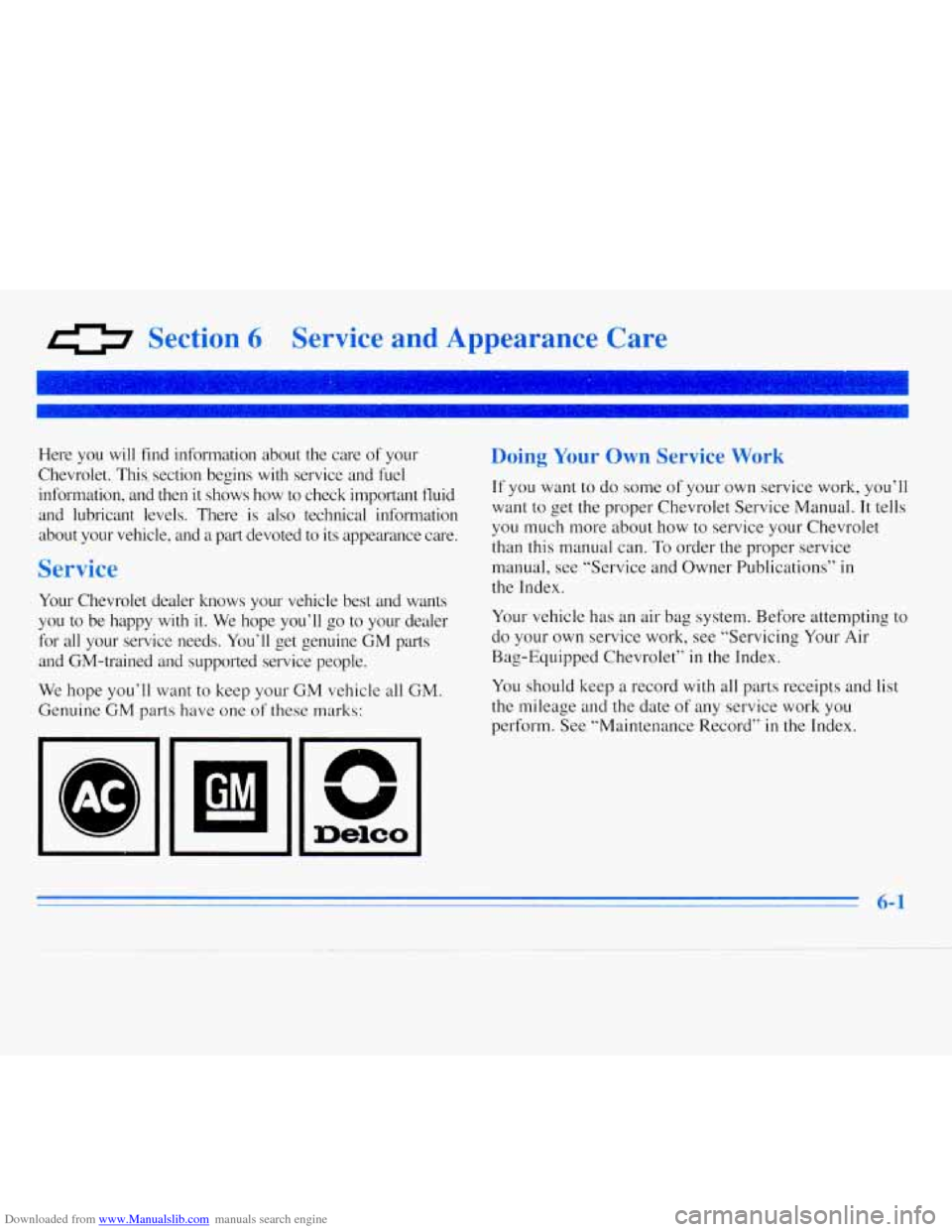
Downloaded from www.Manualslib.com manuals search engine Section 6 Service and Appearance Care
Here you will find information about the care of your
Chevrolet. This, section begins with service and
fuel
information, and then it shows how to check ,important fluid
and lubricant levels. There
is also technical information
about your vehicle, and a p‘art devoted to its appearance care.
Service
Your Chevrolet dealer knows your vehicle best and wants
you to be happy with it. We hope you’ll go to your dealer
for all your service needs. You’ll get genuine GM parts
and GM-trained and supported service people.
We hope you’ll want to keep your
GM vehicle all GM.
Genuine GM parts have one of these marks:
Doing Your Own Service Work
If you want to do some of your own service work, you’ll
want to get the proper Chevrolet Service Manual.
It tells
you much more about how to service your Chevrolet
than this manual can.
To order the proper service
manual, see “Service and Owner Publications”
in
the Index.
Your vehicle has an air bag system. Before attempting
to
do your own service work, see “Servicing Your Air
Bag-Equipped Chevrolet” in the Index.
You should keep a record with all parts receipts and list
the mileage and the date
of any service work you
perform. See “Maintenance Record” in the Index.
n
V
6-1
Page 210 of 340
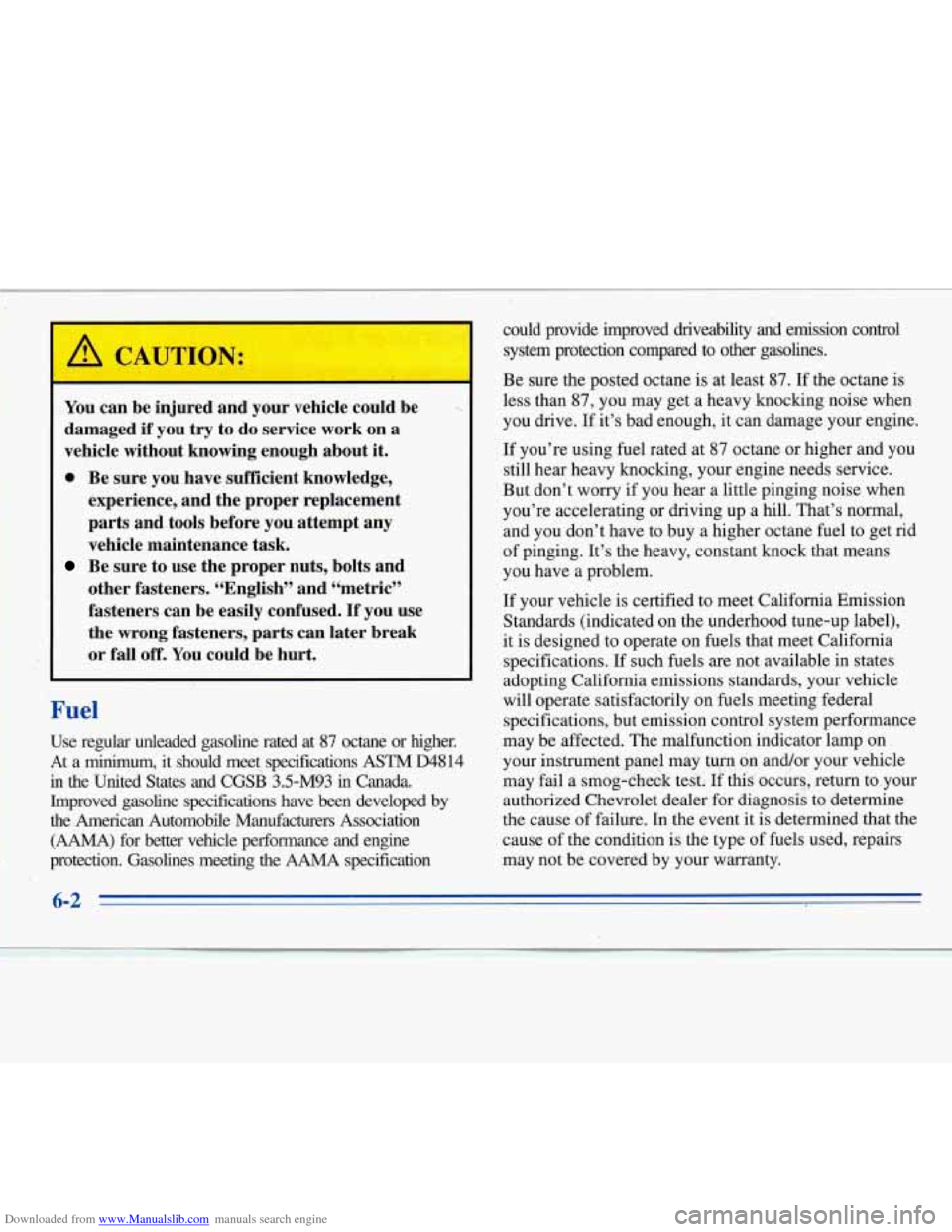
Downloaded from www.Manualslib.com manuals search engine You can be injured and your vehicle could be
damaged if you try to do service work on a
vehicle without knowing enough about it.
0 Be sure you have sufficient knowledge,
experience, and the proper replacement
parts and tools before you attempt any
vehicle maintenance task.
Be sure to use the proper nuts, bolts and
other fasteners. “English” and “metric”
fasteners can be easily confused. If you use
the
wrong fasteners, parts can later break
or fall off. You could be hurt.
Fuel
Use regular unleaded gasoline rated at 87 octane or higher.
At a.minimum, it should meet specificatiom.ASTM D4814
in the United States and
CGSB 3.5-M93 in Canada.
Improved gasoline specifications have been developed by
the American Automobile Manufacturers Association
(AAMA) for better vehicle performance and engine
protection. Gasolines meting
the AAMA specification
~~~ ~ ~~~
could provide improved driveability and emission control
system protection compared
to other gasolines.
Be sure the posted octane is at least 87. If the octane is
less than 87, you may get a heavy knocking noise when
you drive. If it’s bad enough, it can damage your engine.
If you’re using fuel rated at 87 octane or higher and you
still hear heavy knocking, your engine needs service.
But don’t worry if you hear a little pinging noise when
you’re accelerating or driving up a hill. That’s normal,
and you don’t have to buy a higher octane fuel to get rid
of pinging. It’s the heavy, constant knock that means
you have a problem.
If your vehicle is certified to meet California Emission
Standards (indicated on the underhood tune-up label),
it is designed to operate on fuels that meet California
specifications. If such fuels are not available in states
adopting California emissions standards, your vehicle
will operate satisfactorily on fuels meeting federal
specifications, but emission control system performance
may be affected. The malfunction indicator lamp on
your instrument panel may turn on and/or your vehicle
may fail a smog-check test.
If this occurs, return to your
authorized Chevrolet dealer for diagnosis to determine
the cause of failure. In the event it is determined that the
cause
of the condition is the type of fuels used, repairs
may not be covered by your warranty.
6-2